South America Travel Narrative Story: Urucu Natrural Gas Pipeline, Brazil
Story and photography by Ray Waddington.
In 2004 our president, Dr. Ray Waddington, undertook an initial, fact-finding assignment in the Brazilian Amazon Basin. His assignment was planned to be the first of many visits to the area over the next few years. The motivation for the timing of this assignment was the then-recent start of construction on the second of three planned natural gas pipelines through the region.
The first of these pipelines was constructed in the late 1990s and ran from the Urucu gas fields (where large deposits of natural gas had been discovered in 1986) to the isolated city of Coari in Amazonas State. The second, on which construction began in mid 2004, now connects Coari to the Amazonas State Capital, Manaus [this pipeline project has been completed since the original publication of this story in 2004]. The third, which is still awaiting the granting of a construction license, is intended to connect the Urucu gas fields to the State capital of Rôndonia, Porto Velho. As of April 2013 it is still difficult to find reliable information about this third pipeline.
Controversy has surrounded these projects in the form of strong criticism from environmental, missionary and indigenous rights groups for the past few years. They have blamed the first pipeline for the collapse of the ecosystem in and around the city of Coari as well as a rise in crime, violence, poverty, drug trafficking and addiction, prostitution including child prostitution and incidences of sexually transmitted diseases. They have raised concern that the other two pipelines will have similar impacts on the communities through which they will pass. These claims notwithstanding, the Foundation's interest has mainly been on the third pipeline because it has been predicted to have a catastrophic impact on the livelihood of local indigenous groups — some of whom are little contacted or entirely uncontacted — as well as the greatest environmental and social impacts of the three pipeline projects.
I want to preface this report by pointing out to our readers that information regarding these pipelines is difficult to obtain. Unless you read (Brazilian) Portuguese very little gets reported — at least as far as I have been able to find.
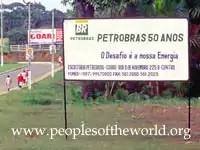
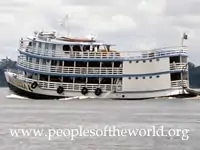 Coari lies about 400 km (250 miles) west of Manaus in the Brazilian State of Amazonas. It is not mentioned in
any of the "mainstream" English-language guidebooks on Brazil. Until recently probably few people had ever heard of it outside of missionaries and
those who study the history of Brazil and/or the history of Portuguese colonialism. It can be reached only by plane or boat.
In 1998 Petroleo Brasileiro SA (better known as Petrobrás), the largest company in Brazil, completed the construction of a
280 km (175 mile) pipeline to conduct natural gas from the Urucu natural gas extraction plant to a newly-built storage
facility, Terminal do Solimões. In writing about a similar construction project, the environmental organization Amazon Watch states
[1]:
Coari lies about 400 km (250 miles) west of Manaus in the Brazilian State of Amazonas. It is not mentioned in
any of the "mainstream" English-language guidebooks on Brazil. Until recently probably few people had ever heard of it outside of missionaries and
those who study the history of Brazil and/or the history of Portuguese colonialism. It can be reached only by plane or boat.
In 1998 Petroleo Brasileiro SA (better known as Petrobrás), the largest company in Brazil, completed the construction of a
280 km (175 mile) pipeline to conduct natural gas from the Urucu natural gas extraction plant to a newly-built storage
facility, Terminal do Solimões. In writing about a similar construction project, the environmental organization Amazon Watch states
[1]:
"In other pipeline projects of this magnitude such as Brazil's Urucu-Coari pipeline and the Bolivia-Brazil pipeline, labor camps near small communities, especially indigenous communities, have caused serious social impacts including:
- Shortages in supply of local food and medicine — in particular shortages caused by over fishing and illegal hunting of wild animals;
- Disturbing traditional hunting grounds — animals driven away by construction noise and activity;
- Sexual assault or harassment of local women;
- Increased prostitution — including child prostitution — and related spread of sexually transmitted diseases;
- Increased colonization and settlement of areas along the pipeline route especially once pipeline construction is completed;
- Increased contamination of local drinking water supplies and spread of disease due to the waste stream from labor camps — especially poor management of sanitation ponds;
- Increased deforestation and the exploitation of natural resources as a result of access to intact areas; and
- Increased violence and criminal activities."
Other environmental groups have written similarly, including Amazônia [2] and Friends of the Earth International [3].
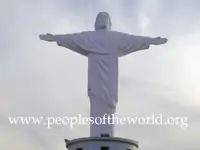
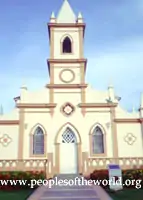 Coari, then, might be described as an ungodly place; although visitors might not conclude this based on its impressive
cathedral and its replica of the famous "Christ the Redeemer" statue in Rio de Janeiro.
Coari, then, might be described as an ungodly place; although visitors might not conclude this based on its impressive
cathedral and its replica of the famous "Christ the Redeemer" statue in Rio de Janeiro.
Although I spent most of my time in Coari with an interpreter, I also ventured into many parts of the city alone. Carrying a camera and a camera equipment bag I could have easily been a target of crime and the threat of crime; I encountered neither.
I interviewed — alone and also through my interpreter — many people in Coari and was struck by the stark local divide in
opinion about the Urucu-Coari pipeline.
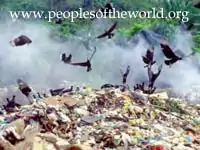 Everyone we spoke to was either totally against it or totally for it!
Typical reasons cited by the "antis" were among those written about by environmentalists and others.
Typical reasons cited by the "pros" had to do with benefits brought to the city as a result of the royalties paid by
Petrobrás in return for gas (and oil) extraction concessions in Coari County. One of those benefits
is the regional hospital in Coari (pictured below left).
Some critics would argue that such a modern hospital is necessary to deal with disease epidemics caused by the pipeline.
Everyone we spoke to was either totally against it or totally for it!
Typical reasons cited by the "antis" were among those written about by environmentalists and others.
Typical reasons cited by the "pros" had to do with benefits brought to the city as a result of the royalties paid by
Petrobrás in return for gas (and oil) extraction concessions in Coari County. One of those benefits
is the regional hospital in Coari (pictured below left).
Some critics would argue that such a modern hospital is necessary to deal with disease epidemics caused by the pipeline.
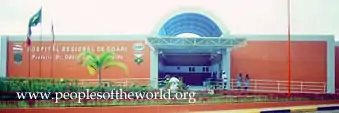 Malaria, for example, has been promoted by the challenge to the local
ecosystem from the rapid population expansion of the city and the destruction of game, fish and water supplies caused by
the construction of the pipeline itself.
Seeing the city garbage dump (pictured above right) most western people would certainly be
shocked to know that this kind of waste disposal is happening in the middle of the Amazon.
Malaria, for example, has been promoted by the challenge to the local
ecosystem from the rapid population expansion of the city and the destruction of game, fish and water supplies caused by
the construction of the pipeline itself.
Seeing the city garbage dump (pictured above right) most western people would certainly be
shocked to know that this kind of waste disposal is happening in the middle of the Amazon.
Other critics would say that modern health facilities are needed in Coari for other reasons. A blogger from Coari, who goes by the name coaripolis has reported [4] that girls as young as 12-years old prostitute themselves there. The European Working Group on Amazonia says that "2% of babies born in Coari have 11- to 14-year old mothers." [5]
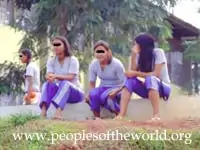
 I observed a few girls in their late teens one evening around the cathedral close to central Coari.
Each of the girls we spoke to said they were on a break from evening classes they were attending at
a nearby college. (Later my guide informed me that prostitution in Coari mainly takes place on weekends; other commitments
precluded my confirming this.) I was informed of after-school programs for young girls in Coari, like this soccer
program. Such programs attempt to give young girls alternate means to pursue
their social life, in acknowledgement that early-age sexual activity is as much a cultural and educational phenomenon in
many parts of Brazil as it is an economic phenomenon [6].
I observed a few girls in their late teens one evening around the cathedral close to central Coari.
Each of the girls we spoke to said they were on a break from evening classes they were attending at
a nearby college. (Later my guide informed me that prostitution in Coari mainly takes place on weekends; other commitments
precluded my confirming this.) I was informed of after-school programs for young girls in Coari, like this soccer
program. Such programs attempt to give young girls alternate means to pursue
their social life, in acknowledgement that early-age sexual activity is as much a cultural and educational phenomenon in
many parts of Brazil as it is an economic phenomenon [6].
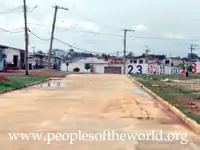
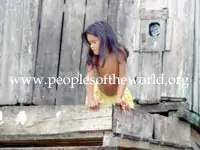 Coari has many "slum" neighborhoods. I had an interesting experience with one of
my fellow passengers from the journey there.
He was from São Paulo; I had dinner with him on my first night there.
He made the observation that he was shocked (on his first visit to the city) at the high standard of living! The photograph
above left was taken on the very outskirts of Coari, near the airport. It is a photograph of a housing project built in 2002. It
certainly looks uninviting to the western eye as a place to live. Yet, in comparison to the photo above right, most people
would probably choose the housing project. What is significant about this comparison is that the slum pictured above right is
much closer to the center than the housing project; Coari has had its slums for longer than it has had its gas pipelines.
Coari has many "slum" neighborhoods. I had an interesting experience with one of
my fellow passengers from the journey there.
He was from São Paulo; I had dinner with him on my first night there.
He made the observation that he was shocked (on his first visit to the city) at the high standard of living! The photograph
above left was taken on the very outskirts of Coari, near the airport. It is a photograph of a housing project built in 2002. It
certainly looks uninviting to the western eye as a place to live. Yet, in comparison to the photo above right, most people
would probably choose the housing project. What is significant about this comparison is that the slum pictured above right is
much closer to the center than the housing project; Coari has had its slums for longer than it has had its gas pipelines.
My conclusions based on my time in Coari are that contemporary descriptions of the social, economic and environmental problems it faces are quite accurate. However I feel that claims that the Urucu-Coari gas pipeline caused or is a major contributor to these problems are exaggerated and naive. Remote areas such as the heart of the Amazon are associated with poverty, lawlessness and corruption the world over. In such circumstances people have always adopted survival strategies out of necessity and crime has always flourished. We surely deny ourselves the opportunity to understand and address these problems if we oversimplify their cause. Anyone who reads (Brazilian) Portuguese can find more about Coari at its two official web portals [7, 8].
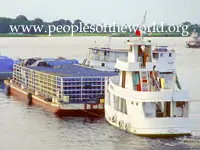
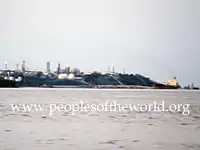 The Coari-Manaus pipeline is important to Brazil. It even has its own web site [9]! It was previously announced as one of
the projects included in the Amazonia Pluri-Annual Plan, 2004-2007 [10]. Today natural gas is transported by barge down the
Amazon River (locally called Rio Solimões) from Coari to Manaus, where it is refined into consumable natural gas.
From there it is transported, also mainly by barge, to many places (including Coari) for consumption. Because of the size
of gas deposits discovered in the Urucu gas fields it is not considered economical to continue this method of transportation
of the unrefined product.
The Coari-Manaus pipeline is important to Brazil. It even has its own web site [9]! It was previously announced as one of
the projects included in the Amazonia Pluri-Annual Plan, 2004-2007 [10]. Today natural gas is transported by barge down the
Amazon River (locally called Rio Solimões) from Coari to Manaus, where it is refined into consumable natural gas.
From there it is transported, also mainly by barge, to many places (including Coari) for consumption. Because of the size
of gas deposits discovered in the Urucu gas fields it is not considered economical to continue this method of transportation
of the unrefined product.
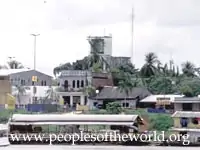 Construction of this pipeline began in mid 2004. It passes through or close to the communities of
Codajás, Anori, Anamã, Caapiranga, Manacapuru and Iranduba.
Of these I was able to visit Manacapuru and the
pipeline's destination, Manaus. The only community of any size along this route is Codajás, pictured left; the others are
small villages containing at most a few hundred people.
Construction of this pipeline began in mid 2004. It passes through or close to the communities of
Codajás, Anori, Anamã, Caapiranga, Manacapuru and Iranduba.
Of these I was able to visit Manacapuru and the
pipeline's destination, Manaus. The only community of any size along this route is Codajás, pictured left; the others are
small villages containing at most a few hundred people.
Critics have predicted that the same problems to befall Coari will also be visited on these communities once the pipeline
is built. Some of those critics live in the communities through which the pipeline will pass [11].
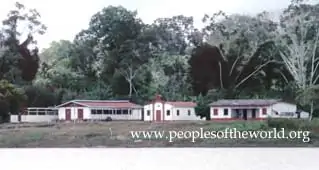 The controversy has
delayed the licensing and construction of the project many times. Now that construction is complete, it will be interesting
to monitor what is written about the project over the next few years. It is likely that reports will emerge
portraying these communities in the same light as previous accounts have portrayed Coari.
The controversy has
delayed the licensing and construction of the project many times. Now that construction is complete, it will be interesting
to monitor what is written about the project over the next few years. It is likely that reports will emerge
portraying these communities in the same light as previous accounts have portrayed Coari.
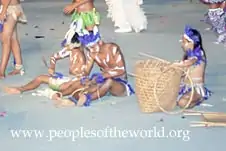 My visit to Manacapuru was mainly for the annual folkloric festival there, Festival de Ciranda [12]. I also
interviewed local inhabitants about the pipeline.
Most of those I spoke to said they were unaware of the project. After I
informed them the typical reaction was that Manacapuru already had the same problems to some extent.
My visit to Manacapuru was mainly for the annual folkloric festival there, Festival de Ciranda [12]. I also
interviewed local inhabitants about the pipeline.
Most of those I spoke to said they were unaware of the project. After I
informed them the typical reaction was that Manacapuru already had the same problems to some extent.
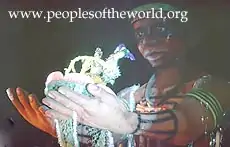 Similarly in Manaus
many people were unaware of the pipeline project. They also represented Manaus as a city with grave social, economic and
environmental problems. Unlike during my time in Manacapuru, I was able to confirm some of these claims in various
suburbs of Manaus that I visited.
Similarly in Manaus
many people were unaware of the pipeline project. They also represented Manaus as a city with grave social, economic and
environmental problems. Unlike during my time in Manacapuru, I was able to confirm some of these claims in various
suburbs of Manaus that I visited.
The third pipeline, planned to connect the Urucu gas fields to the State capital of Rôndonia, Porto Velho, is probably the most controversial of the three pipeline projects. It is of interest to the Peoples of the World Foundation mainly because it has been claimed to adversely affect many indigenous groups including the Apurinã, Banawá, Diahoy, Deni, Jarawara, Jamamadi, Paumari, Pirahã, Rimarimã, Tenharim and Torá. The most active opponent to this project has been Friends of the Earth International. That organization made a 22-minute documentary film, Petrobras' Next Accident: The Licensing Farse, available in Windows Media (WMV format) in Portuguese with English subtitles, at [13]. It recently ran a campaign against the project and, in its 2003 annual report [14] claimed suspension of the project's license as a campaign victory. A more recent report [13] suggests that this victory might be short-lived.
At the time of writing this report (November 19, 2004) the third pipeline is still undergoing licensing: Whether it will ever be constructed is a matter of debate. A second matter of debate is the exact impact it would have on local indigenous groups. Little has been written specifically about that topic. Amazônia [15] published a summary in 2002 of a study on the topic by anthropologist Gunter Kromer. Probably the most detailed publication comes from the Inter-American Development Bank [16]. In an annex (appendix) to one of its reports, the authors present actual data from a survey of those potentially affected by the pipeline. Unfortunately the material does not include ethnolinguistic group as part of its demographic data.
I visited Porto Velho as part of this assignment. I interviewed a number of people living locally and working for either the Summer Institute of Linguistics or Youth with a Mission organizations. Each works in some capacity with various local indigenous communities. After seeing a map of the proposed route of the pipeline, one person with intimate knowledge of the area stated that it did not pass through or close to any areas populated by indigenous groups. Such a statement should, of course, be taken for what it is worth, given that there has been little or no contact with many of the groups in the area!
I was particularly interested in visiting the Pirahã. Around the time of my assignment they were becoming known to the western world because of the fascinating work conducted by linguist Daniel L. Everett [17, 18]. This work is too detailed to describe here. It rekindles an old debate in the field of psycholinguistics, first proposed as the Sapir-Whorf hypothesis, which proposes a mapping between concepts that a language contains and the ability of its speakers to conceive them. In the case of the Pirahã, Everett's work questions whether basic math (the ability to count beyond the quantity, three) can be determined by the language one learns. The implications of this work reach into fields such as cognitive psychology, Darwinian evolution, philosophy of mind, artificial intelligence and many others. Although I had a guide in the area who had contact with, and had volunteered to accompany me to, Pirahã villages, I was refused permission to enter their territory by the local office of FUNAI (the Brazilian federal government agency that is responsible for overseeing indigenous peoples).
Based on my findings in Brazil, I recommended to our Board of Directors that we place our work in Brazil on hold. We will continue to monitor the situation and, depending on developments and permission from FUNAI, may continue this work.
Photography copyright © 1999 -
2025,
Ray Waddington. All rights reserved.
Text copyright © 1999 -
2025,
The Peoples of the World Foundation. All rights reserved.
Waddington, R., (2004) Urucu Natrural Gas Pipeline, Brazil. The Peoples of the World Foundation. Retrieved
November 15, 2025,
from The Peoples of the World Foundation.
<https://www.peoplesoftheworld.org/travelStory.jsp?travelStory=urucu>
Web Links
[1]
Amazon Watch, (2001) The New Heavy Crude Pipeline in Ecuador: Fueling a Second Oil Boom in the Amazon.
[2]
Amazônia, (2003) Living the Tragedy of a Pipe Dream.
[3]
Friends of the Earth International, (2002) History Repeats Itself in the Brazilian Amazon:
Dangerous Plans for Petrobas Pipeline.
[4]
Coaripolis, (2004) Prostituição Infantil. (This article is in Portuguese)
[5]
European Working Group on Amazonia, (1997) Urucu Hydrocarbon Project.
[6]
Assembléia Legislativa do Amazonas, (2004) Prostituição Infantil Preocupa Mário Frota.
(This article is in Portuguese)
[7]
Coari, City Web Portal.
(This site is in Portuguese)
[8]
Coari, City Web Portal.
(This site is in Portuguese)
[9]
State Government of Amazonas, Portal Oficial do Governo do Estado do Amazonas.
(This site is in Portuguese)
[10]
Amazônia, (2004) Amazonia in the Pluri-Annual Plan 2004-2007.
[11]
Amazônia, (2004) Riverains Condemn Coari-Manaus Gas Pipeline.
[12]
Portal Amazônia, (2004) Festival de Ciranda de Manacapuru 2004.
[13]
Amazônia, (2004) Term of Engagement Fails to Compel Petrobras to Fulfil Urucu-Porto Velho Licensing Requirements.
[14]
Friends of the Earth International, (2003) Annual Report 2003.
[15]
Amazônia, (2002) Evaluation of the Impacts of the Urucu-Porto Velho Gas Pipeline on Indigenous Populations in the
Region by Anthropologist Gunter Kromer.
[16]
Inter-American Development Bank, (2003) Urucu-Porto Velho Gas Pipeline. (Annex 1 of Termonorte Thermoelectric
Power Project: Environmetnal And Social Impact Report.)
[17]
Everett, D. L., (2004) Cultural Constraints on Grammar and Cognition in Pirahã:
Another Look at the Design Features of Human Language.
[18]
Amazon Tribe Has No Words for Different Numbers.
If you enjoyed reading this travel story, please consider buying us a coffee to help us cover the cost of hosting our web site. Please click on the link or scan the QR code. Thanks!


